A version of this blog post was first published on the Vermont Sail Freight’s Captain’s (b)log
In a January 2014 on my blog I talked about the choices this old “sailor” was considering as I looked at 70. In that piece I wrote about my interest in the Vermont Sail Freight
 Project, “the Vermont Sail Freight Project is the furthest along of these ideas. Founded and implemented by Erik Andrus a farmer in Ferrisburgh, VT. VSFP is a slow tech approach to energy and a resilient food system.
Project, “the Vermont Sail Freight Project is the furthest along of these ideas. Founded and implemented by Erik Andrus a farmer in Ferrisburgh, VT. VSFP is a slow tech approach to energy and a resilient food system.
Erik has said about the project, “The Vermont Sail Freight Project originated out of our farm’s commitment to resilient food systems. Producing food sustainably is not enough. The other half is sustainable transport of goods to market and equitable exchange. A good portion of the damage conventional agriculture does to society and the environment is through our overblown, corporation-dominated distribution systems. The idea of a small, producer-owned craft sailing goods to market, perhaps even a distant market, is an alternative to this system, and one which has served our region well in the past. “
I signed on in significant part because Ceres, Erik, and the crew confirm my belief in preserving the skills of the past to serve the future. The Vermont Sail Freight Project appealed to my head and heart in significant part because I agreed with Erik when he said to a member of a television crew, “I offered my belief that contrary to the techno-paradise that some expect, my belief is that our future will likely resemble our past, and that we may fall back on proven, low energy approaches to supporting human life that have been historically proven to work. “Isn’t that pessimistic?” asked the interviewer. I replied that I don’t think so. It is in my view even more pessimistic to imagine a world continuing on the current path, becoming a place in which there is no place for human labor or creativity, where rather than doing things with our backs and hands and minds, we must instead wait passively for conveniences and solutions to be marketed to us. That, to me, is the most depressing future imaginable.”
fall back on proven, low energy approaches to supporting human life that have been historically proven to work. “Isn’t that pessimistic?” asked the interviewer. I replied that I don’t think so. It is in my view even more pessimistic to imagine a world continuing on the current path, becoming a place in which there is no place for human labor or creativity, where rather than doing things with our backs and hands and minds, we must instead wait passively for conveniences and solutions to be marketed to us. That, to me, is the most depressing future imaginable.”
The adventure started when I picked up Captain Steve Schwartz on my way to Vermont. I met Steve briefly late last summer before Ceres’ first trip, and we exchanged emails when he learned that I was going to be a crew member. We talked constantly all the way from 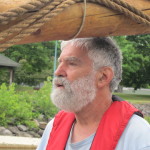 the Hudson Valley to Erik’s farm. It turns out we are close enough in age to share musical taste and Vietnam War draft board experiences. (Maybe I will do another post about this to the tune of Alice’s Restaurant).
the Hudson Valley to Erik’s farm. It turns out we are close enough in age to share musical taste and Vietnam War draft board experiences. (Maybe I will do another post about this to the tune of Alice’s Restaurant).
We also have Hudson and Harbor stories and friends in common from Steve’s long term commitment to Clearwater as Captain of the Sloop Woody Guthrie, to his friendship with and my appreciation of the work and life of Pete Seeger, from my days as mate on the Schooner Pioneer, and because of the people I met during my 20 years on the water in the Harbor and lower Hudson as the NY/NJ Baykeeper.
The next few days were an amazing ballet (or rugby scrum depending on your point of 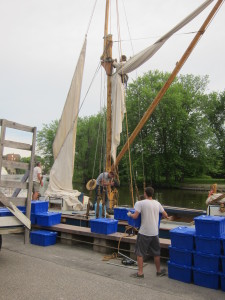 view) of riggers adding a topsail and outer jib, food shopping for a crew of four, moving and loading the cargo totes, trading one ailing outboard for a used but working one, deciding on last minute changes to the schedule, loading on personal gear, and finally getting underway.
view) of riggers adding a topsail and outer jib, food shopping for a crew of four, moving and loading the cargo totes, trading one ailing outboard for a used but working one, deciding on last minute changes to the schedule, loading on personal gear, and finally getting underway.
But more than that I learned firsthand why Erik is so passionate about this project. One of the reasons he asked me to help out for a few critical weeks was because he was in the middle of planting rice in a “paddy” that he had constructed in a low lying part of his farm. It was eye opening to see what goes into the preparation and planting of this specialty northern variety.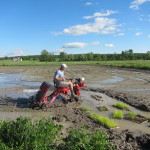
He was also up early baking bread, for sale at a nearby farmers market from local grains in the wood fired oven that he had built. Erik’s quest for resilient food became more apparent as I saw the dedication to local production and distribution that the bakery epitomized and that the care that 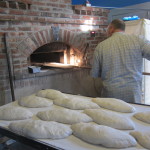 went into the preparation of the muddy field for the rice.
went into the preparation of the muddy field for the rice.
It was also apparent that he put the same kind of thoughtfulness and consideration (and appropriate business model) into buying the local shelf stable products outright from neighboring farmers. The cargo of mostly Vermont maple syrup, honey, preserves, cider syrup, “fire” cider, herbal teas, grains, flour, and beans meant cash in the pocket at a time when many farmers are strapped.
I watched from land as Ceres left the town dock in Vergennes, turned down stream just 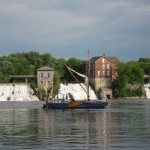 under the falls and disappeared around the bend in Otter Creek on the way to the Lake. Ceres and her crew, Captain Steve, Meade Atkeson, and Matt Horgan spent the first night anchored in one of the most beautiful shorelines on Lake Champlain, Button Bay just off the State Park. The next morning Erik rejoined the boat along with Edward and Gary from the French television program Thalassa for the trip down the Lake. I was not on board (that’s a whole other story), but. I was fortunate to stand on a bluff above the bay and able to watch the boat get underway,
under the falls and disappeared around the bend in Otter Creek on the way to the Lake. Ceres and her crew, Captain Steve, Meade Atkeson, and Matt Horgan spent the first night anchored in one of the most beautiful shorelines on Lake Champlain, Button Bay just off the State Park. The next morning Erik rejoined the boat along with Edward and Gary from the French television program Thalassa for the trip down the Lake. I was not on board (that’s a whole other story), but. I was fortunate to stand on a bluff above the bay and able to watch the boat get underway, 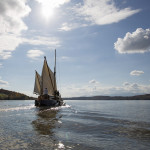 and raise all sail for what proved to be an amazing downwind “sleigh ride,” shaking out the new topsail that Steve described as a “turbocharger.”
and raise all sail for what proved to be an amazing downwind “sleigh ride,” shaking out the new topsail that Steve described as a “turbocharger.”
I caught up with the boat at Whitehall, NY. Whitehall is like a town encased in amber. Its 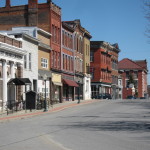 nineteenth century brick buildings face the canal, many empty and waiting for the resurgence of canal traffic to reanimate this once thriving town. It was at Whitehall that we took the rig down (with the boat’s own gear) for the canal passage. We spent the evening in a waterfront bar, as sailors should, and got underway through the first of ten locks the next morning. This was my first trip through the canal, and the only other lock I had been through was the one connecting Lake Union to the Puget Sound in Seattle. Steve was a veteran of last year’s trip and drilled the crew on handling the boat through the locks.
nineteenth century brick buildings face the canal, many empty and waiting for the resurgence of canal traffic to reanimate this once thriving town. It was at Whitehall that we took the rig down (with the boat’s own gear) for the canal passage. We spent the evening in a waterfront bar, as sailors should, and got underway through the first of ten locks the next morning. This was my first trip through the canal, and the only other lock I had been through was the one connecting Lake Union to the Puget Sound in Seattle. Steve was a veteran of last year’s trip and drilled the crew on handling the boat through the locks.
The Champlain Canal is a 60 miles long. It connects the south end of Lake Champlain, to 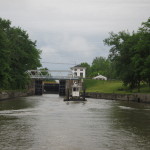 the Hudson River. It was built at the same time as the Erie Canal and was completed and opened in 1823 from Fort Edward to Lake Champlain. The canal carried commercial traffic until the 1970’s. Today, except for the tugs, crew boats, dredges, and barges connected to the General Electric PCB clean up, most of the traffic is recreational boats that can travel up Lake Champlain to the Chambly Canal that connects the Lake to the Saint Lawrence Seaway.
the Hudson River. It was built at the same time as the Erie Canal and was completed and opened in 1823 from Fort Edward to Lake Champlain. The canal carried commercial traffic until the 1970’s. Today, except for the tugs, crew boats, dredges, and barges connected to the General Electric PCB clean up, most of the traffic is recreational boats that can travel up Lake Champlain to the Chambly Canal that connects the Lake to the Saint Lawrence Seaway.
